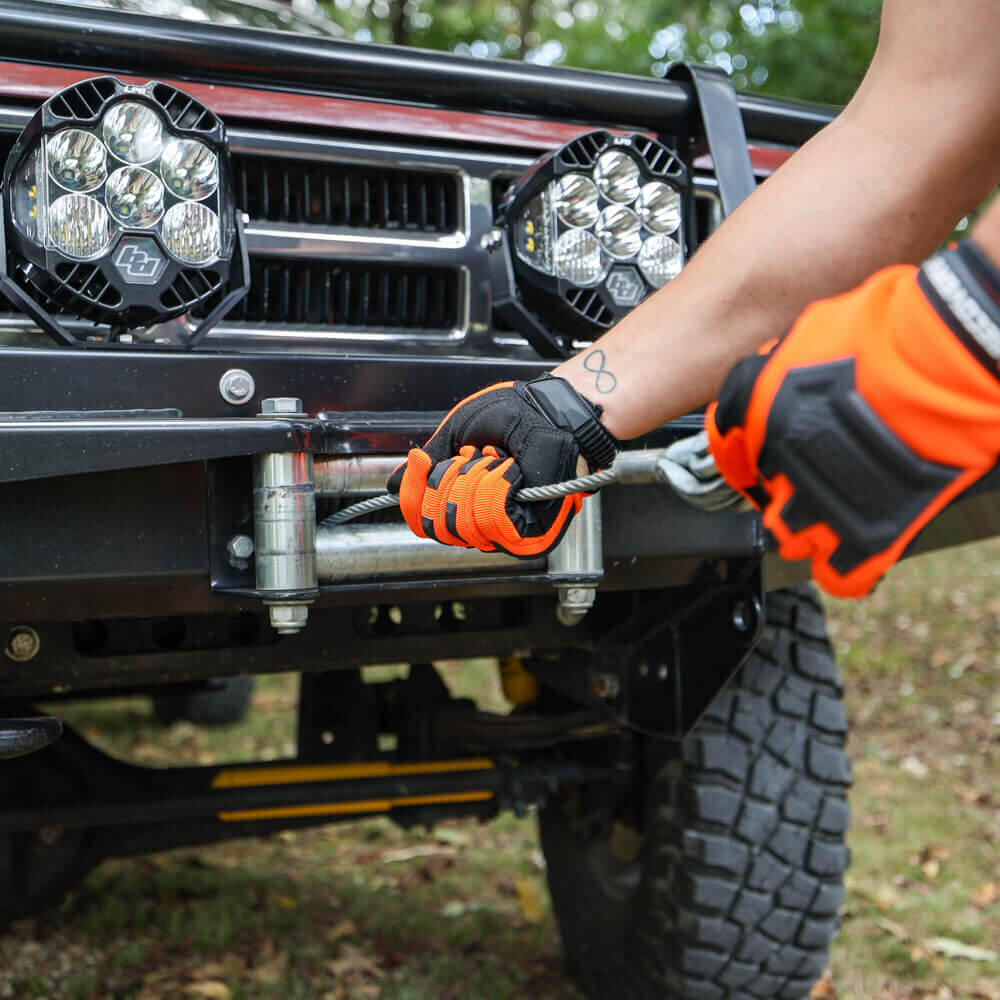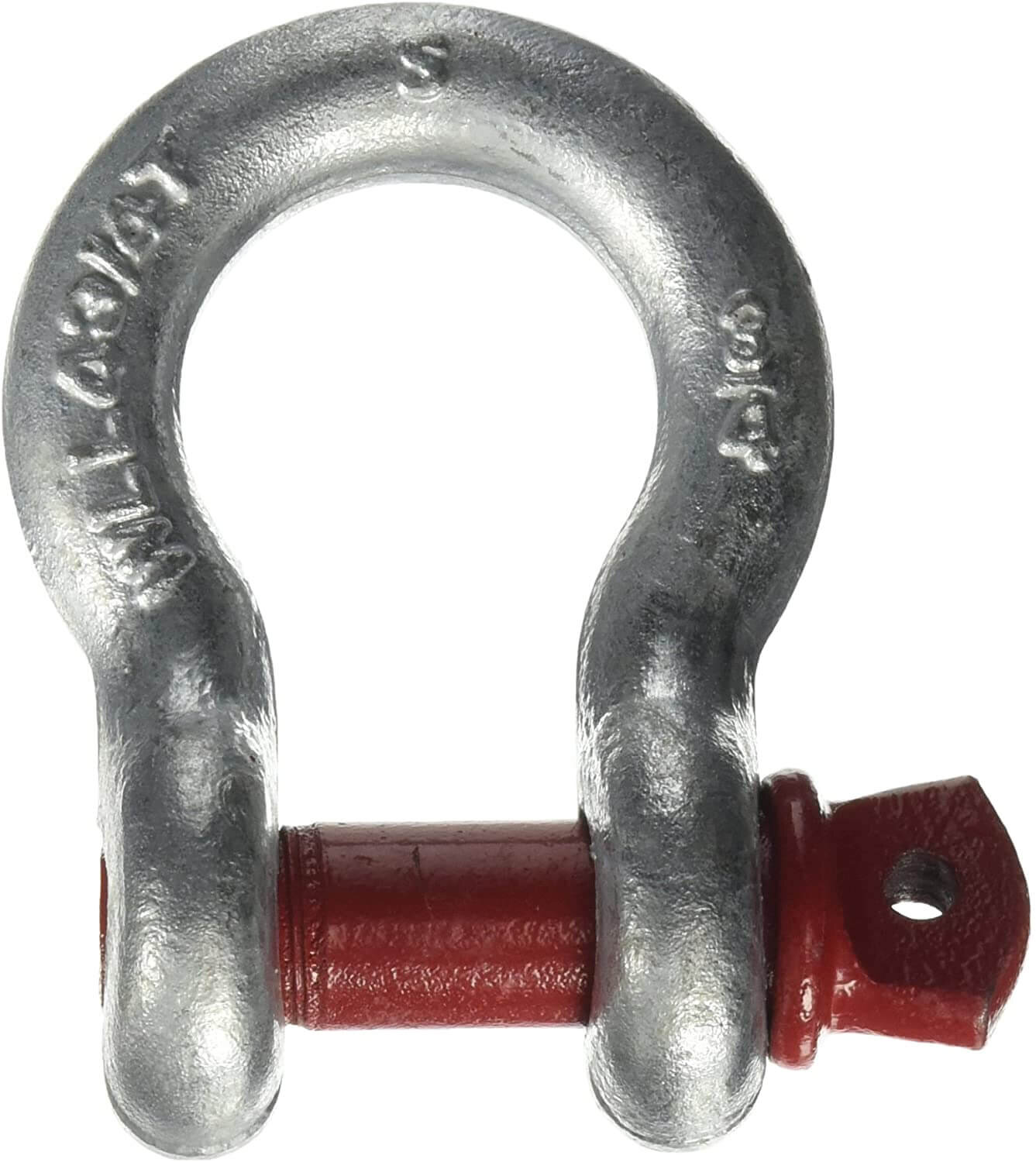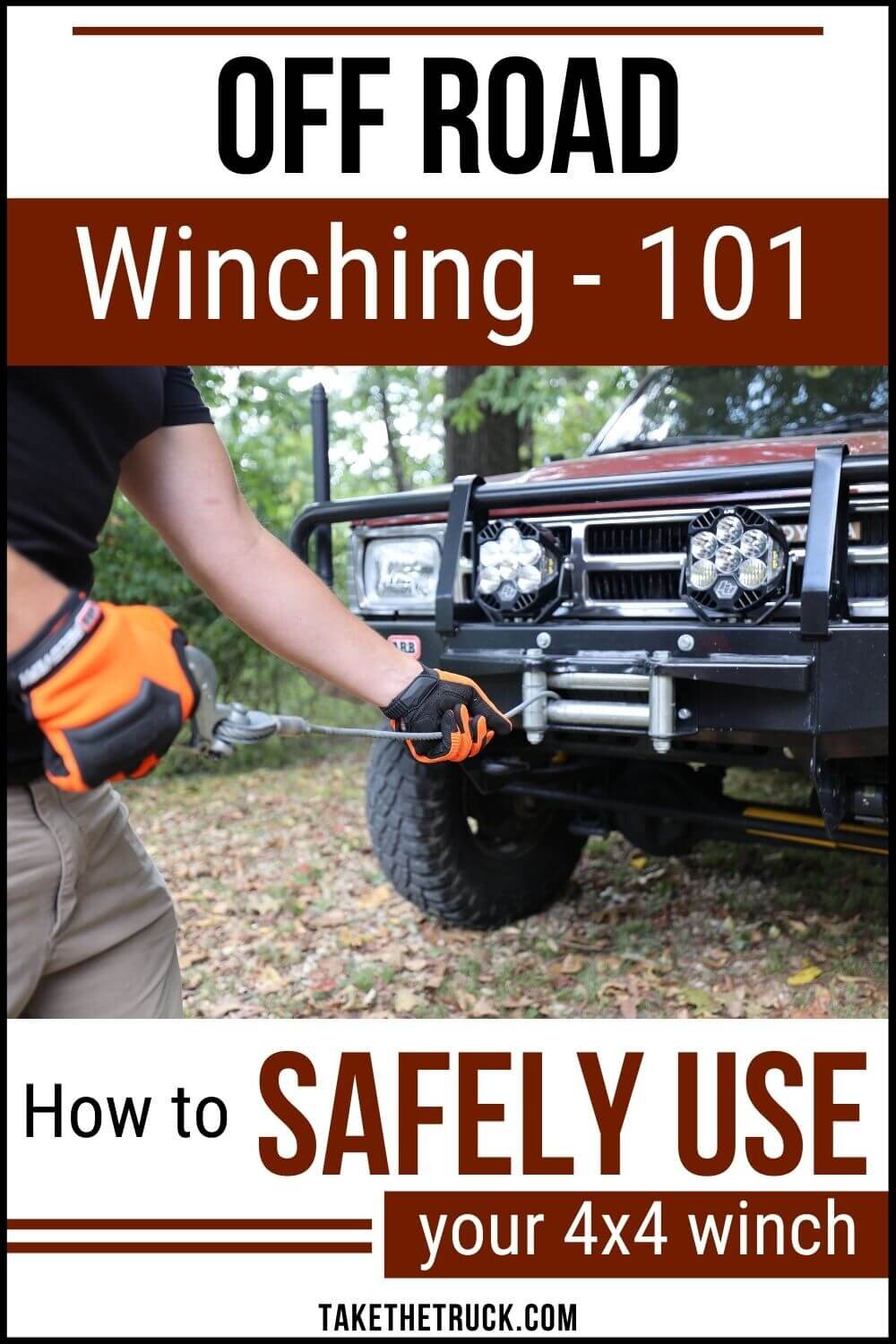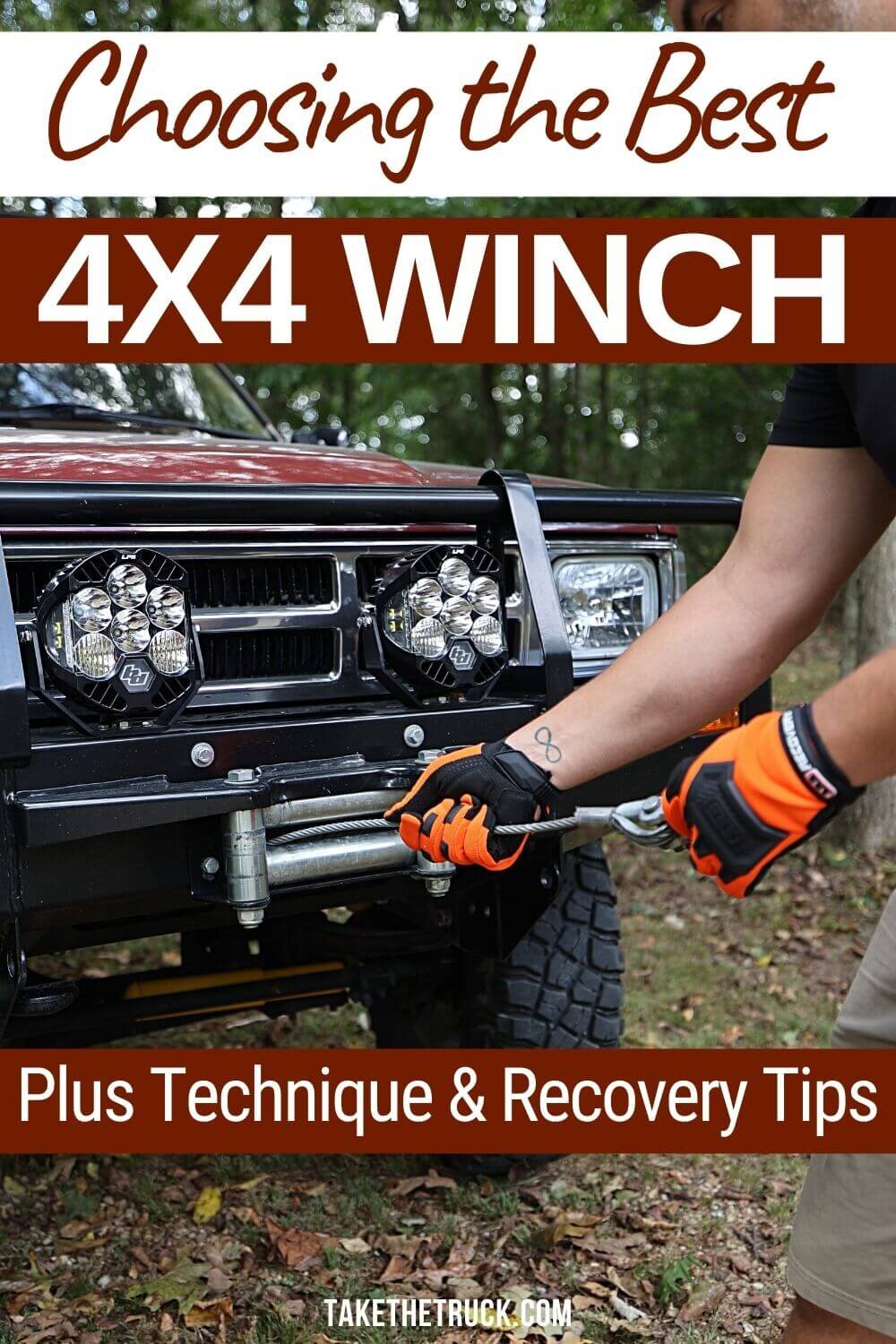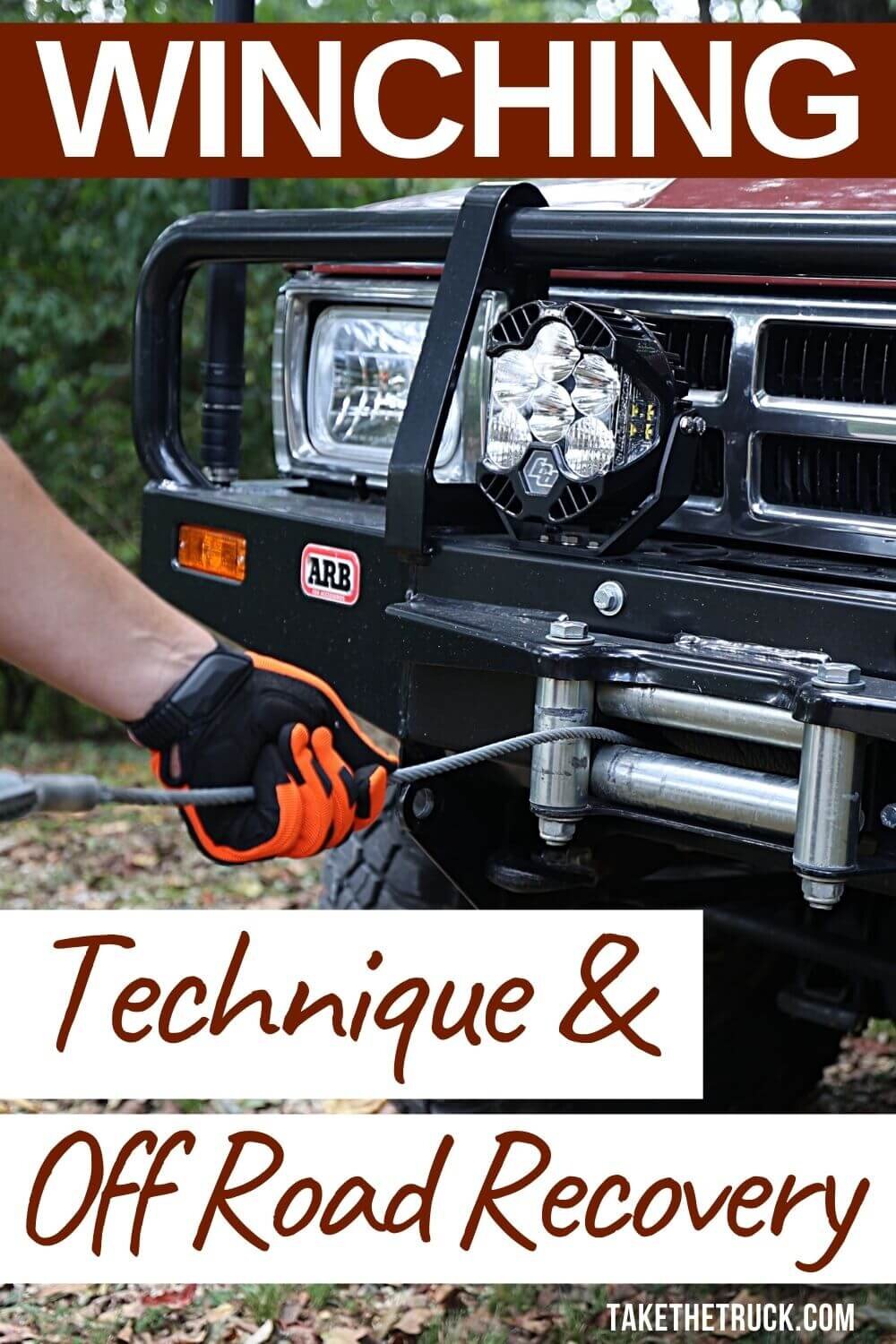How to Choose and Use a 4x4 Winch [Basic Winching Techniques]
Becoming skilled and effective at off road winching is incredibly valuable to anyone interested in overlanding or off-roading.
In this guide we’ll walk through the process of selecting the right 4x4 winch for your vehicle, discuss the equipment needed for winching safely and effectively, and go over how to use your 4x4 winch, recovery gear, spotters, and hand signals to perform a vehicle recovery off road.
*(This post contains affiliate links. This means we may receive a small commission, at no additional cost to you, if you make a purchase through a link. See our full disclosure.)
How to Select The Right Winch
The best way to choose a winch for your rig is to first calculate the max load you expect your vehicle to place on the winch, so you can select a winch with an adequate rated line-pull or capacity for a variety of recovery scenarios. And then determine what type of winch line meets your needs.
Choosing a Properly Rated Winch
1. Determine your vehicle’s fully-laden Gross Vehicle Weight (GVW) - this can be done by fueling up and packing all your gear, equipment, and family into your rig and heading to any public Certified CAT Scale.
2. Now Multiply the Vehicle’s GVW by 1.5 – this will give you an approximation of the minimum capacity winch you’d need. And we’d recommended choosing a winch with a capacity (rated line pull) between 1.5 and 2 times GVW.
Here’s what that looks like:
If the GVW is 5000 lbs.
Multiplied by 1.5, we’d get 7500 lbs. That’s the minimum capacity winch you’d want to consider. And 2x GVW would be 10000 lbs.
So we’d consider any winch rated between 7500-10000 lbs adequate.
*Note that winches are typically rated by their MAX load-handling ability which is when the winch line is all the way out with only one spooled layer of line remaining around the winch drum. Each additional layer spooled around the drum loses about 10% of the load capacity. So for a winch rated at 8,000lbs, with two layers of line spooled on the drum it will effectively pull 7,200lbs, with three layers 6,400lbs, and so on.
Synthetic vs. Steel Winch Line
The winch line is one of the most crucial parts of your 4x4 winch, as it bears the full load of your vehicle during a winching recovery.
Because of its importance, the debate between synthetic and steel winch lines has been fairly contentious since synthetic winch lines came onto the market in the 1990s - with strongly opinionated arguments for and against each option - making it hard to decide which winch line to go with.
But the decision ultimately boils down to your personal winching needs, usage, and budget - so here are some basic pros & cons of each type to help you decide:
Steel Winch Line - is the traditional industry standard constructed of braided aircraft-grade steel cable
Pros:
Less expensive
Highly abrasion resistant - making it great for mud, sand, and rocky terrain
Requires less maintenance
Not impacted by UV exposure
Cons:
Heavy
Can kink creating weak points
Can rust and develop sharp burrs as it wears and is exposed to moisture
Stores more kinetic energy, which makes it substantially more dangerous if a break occurs during a recovery
Can’t be repaired in the field if a break occurs
Synthetic “Rope” Winch Line - is typically made of very specialized hi-tech stranded polyethylene similar to marine rope
Pros:
Light-weight
Higher breaking strength
Stores less kinetic energy, making it less dangerous if breakage does occur during a recovery
Doesn’t kink and is easier to spool onto the winch drum
Can be spliced and repaired in the field in the event of a break
It Floats - which is handy for vehicle recoveries in water crossings or mud
Cons:
More expensive
Less abrasion resistant
More susceptible to UV exposure degradation, chemicals (like your vehicle’s gasoline or oil), and heat
Requires frequent maintenance and cleaning
Can retain water making it susceptible to freezing on the winch drum
Warn winches are the gold standard in off-road winching, and we’ve personally had excellent experience with them over the years.
Warn’s line of 4x4 winches include models pre-spooled with either steel winch line or synthetic winch line, or they offer conversion kits to switch from one to the other if desired. They offer 4x4 winch options in a variety of capacities* to accommodate any off road or overland vehicles’ weight. Plus their optional remote winch controller* makes it easier to operate your winch from a safe distance.
We’ve personally used the Warn M8000 Winch for over a decade of off road adventures and overland travel. Its combination of high quality build, budget-friendly price, and the fact that it’s 8000lb capacity is suitable for a wide variety of compact and mid-size trucks and SUVs makes it one of the best off road 4x4 winch options on the market. Check out our complete review and guide to the Warn M8000 to see if it’s right for you.
Other 4x4 Winching Recovery Equipment You’ll Need
Tree Saver Strap* - A relatively short strap that is typically sleeved with a protective layer and used to protect trees when being used as an anchor point during an off road recovery that requires a winch.
Bow Shackles | D-Ring Shackles | Soft Shackles - bow shackles, D-ring shackles, and soft shackles are all used to provide a secure connection to an overland vehicle’s recovery points or other strap/winch line juncture used in off-road vehicle recovery systems.
Though they’re often referred to interchangeably, Bow Shackles have a distinct rounded or “bowed” loop shape allowing for multi-directional pulling at the compromise of typically lower load rating - especially at extreme off-angle pulls. For instance, at a 45 degree off-angle the load rating of a bow shackle is decreased by 30%, and at a 90 degree off-angle it’s reduced by 50%.
D-ring Shackles have a narrower “D” shaped loop providing a typically higher load rating but are only intended for directly forward linear pulls.
Soft Shackles, like this popular model by Bubba Rope*, are made of synthetic high modulus polyethylene rope (similar to synthetic winch line material) that offers a typically higher load rating and breaking strength in comparison to steel bow shackles or D-ring shackles. They can be pulled at off-angles and because they’re significantly lighter they’re considered safer than steel shackles in the event of a failure. For these reasons, soft shackles are generally the preferred option to use in most recovery scenarios.
Winching Gloves* - There are a lot of ways to injure a hand during an off road winching recovery, and winching gloves can help to protect them
Snatch Block* - A snatch block is a small single-pulley winching device that is placed around your winch line to facilitate a variety of self-recovery and off road vehicle recovery techniques while winching.
The principal benefit of using a snatch block (or two) in a winching recovery, is to decrease the working load on your vehicle’s electric winch.
By creating a multi-line pull using a snatch block, you can compound your winch’s mechanical pulling efficiency. (This is covered in greater detail in the winching video below - in which it’s often referred to as a “pulley block”)
4x4 Winch Line Recovery Damper* - A winch line recovery damper is a safety device that typically consists of a thick weighted fabric that is draped over the winch line, prior to a load being placed on it, to “dampen” or absorb some of the kinetic energy of the line in the event of a winch line, strap, or shackle failure.
Another great recovery damper strategy involves tying a short (but slack) secondary synthetic safety rope to the winch line prior to a load being placed on it, using a prusik knot so that it can be easily adjusted.
This will help to control the kinetic energy of the winch line in the event of a shackle or anchor point failure.
These winch line recovery dampers can be used in conjunction to provide a higher degree of security while winching off road.
Winch Line Extension* - A winch line extension is typically a synthetic rope, strap, or sometimes wire rope used to extend the pulling length of your vehicle’s electric winch when an anchor point is too far from the stuck vehicle’s position.
Though you can piece together this winching recovery gear yourself into a custom kit, we feel the ARB Premium RK9 kit* offers a good mixture of recovery gear to get you started at a relatively decent value. It’s the kit we still use today (though we have added a few soft shackles, bow shackles, and a new pair of winching gloves to our kit over the years).
How a Winch Works
At its most basic an electric winch utilizes an electric motor to rotate a drum via a series of gears, which in turn either spools winch line in or out through the fairlead to a specified anchor point with the intention of moving either the vehicle the winch is attached to OR the anchor point (in the event of recovering another vehicle or moving a downed tree that’s blocking the trail). Let’s walk through the structural components of the winch shown in the diagram below:
Electric Winch Motor - typically powered by the vehicle’s starting battery or secondary battery (in a traditional dual battery setup), the winch motor provides power to the Gear Train, which in turn rotates the Winch Drum, spooling the winch line in or out.
Control Box - contains all the electronic circuitry of the winch, the solenoids (effectively heavy-duty relays), and the winch’s Remote Socket. Sometimes the Control Box is a separate piece that can be mounted remotely (like ours on our Warn M8000 which we installed inside the engine bay to keep it more protected from the elements) or on some models it’s mounted inside the sealed winch housing.
Remote Socket - Connection point for a wired or wireless Remote.
Winch Drum (and Internal Braking System) - the cylindrical drum (also referred to as a winch spool) that the Winch Line is affixed to and spooled around. On most electric winch models, the winch’s Internal Braking System is housed in the center of the winch drum preventing slack in the winch line by stopping the Drum from continuing to rotate once you’ve stopped powering the winch in or out via the Remote.
Winch Line - spooled around the Drum and passing through the fairlead, with one end physically attached to the drum typically with a bolt and the other end having an open eyelet (known as the thimble) for attaching a winch hook.
Gear Train - the Gear Train transfers the motor’s power to the Winch Drum while compounding this power into a substantially greater rotational force through gear reduction - giving the winch it’s pulling power.
Clutch - The Clutch Control is typically a lever on the gear train side of the winch housing, but on some models it can be a button on the Winch Remote. The electric winch Clutch Control only has two settings – Freespool and Engaged - allowing you to manually disengage the Drum from the Gear Train – this is called freespooling. In freespool, you can manually pull the line off the winch drum by hand without resistance from the winch motor and gearing. Once you have pulled the desired amount of line out to your anchor point, you can select the Engaged setting - “engaging” the spooling drum once again to the Gear Train and Motor.
Fairlead - guides the Winch Line onto the Drum, while minimizing winch line wear as the line enters or leaves the winch at off-angles. There are two primary types of fairleads – roller and hawse.
Roller Fairleads - use four metal “rollers” to guide and protect the winch line as it spools in or out. This type of fairlead is typically best suited for use with steel cable winch lines.
Hawse Fairleads - do not use rollers, but instead use a smooth machined aluminum surface to guide and protect the winch line as it spools in and out. Hawse fairleads are best suited for use with synthetic rope winch lines.
Hook - attached to the eyelet at the terminus of the winch line (referred to as the winch line thimble) using the hook’s clevis. The Hook provides a fast means of attaching to a suitable anchor point via other pieces of recovery gear like a bow shackle, soft shackle, tree saver strap, etc.
Hook Safety Strap - a Hook Safety Strap is used to hold the Hook from a safe distance as the winch line is spooled back onto the drum in order to keep your fingers and hand away from the fairlead to prevent injury.
Remote (Winch Controller) - a wired or wireless control that plugs into the winch Control Box via the Remote Socket allowing you to stand at a safe distance from the winch when performing a recovery - remotely controlling the direction of rotation of the Drum to feed the Winch Line in or out.
How to Use Your Winch
Like any other skill, it takes training and practice to become proficient at winching, and the best way to gain this proficiency is to go out with a group of experienced off-roaders for some direct experience. If you don’t know any, Overland Expos, Events, Groups, and Rallies are a great place to meet some.
With that said, the below video is one of our favorite (albeit dated) winching recovery training videos to help get you started:
We also recommend using Warn’s free winching technique guide as an excellent reference as well!
Basic Winching Safety Tips
Safety is the MOST paramount facet of winching off road; take time to ingrain safety routines into your winching practice and operation, be methodical, and when in doubt STOP and reassess any recovery situation. While we can’t possibly cover every safe-winching scenario, here are a few general safety tips to always keep in mind as you get started:
Before using your new winch for the first time, the winch cable should be respooled tightly around the winch drum while under load, before performing any recovery pulls. This is done so that there are no gaps in the layers of spooled cable for the load-bearing winch line to fall into - potentially becoming pinched and/or bound in the layers below.
Always anchor at the base of a tree or rock using a tree saver strap, never wrap the winch line directly around the anchor point, and whenever possible avoid routing the winch line over rock edges which can be abrasive and damaging to the line under load.
Always triple check your connection points before placing a load on the line:
Ensure bow shackles are fully threaded and oriented correctly (no side-loading), and soft shackles are properly attached
Ensure anchor points on vehicles are properly load rated and attached to the frame
Ensure bystanders (those not involved directly in the recovery) are positioned out of harm's way - away from the winch line, preferably behind an object such as a vehicle, tree, boulder, etc. and never between the problem vehicle and anchor point.
Never straddle or cross a winch line that is under load
Using a Spotter While Winching Off Road
When driving off road or performing an off-road recovery using a winch, a spotter is someone who stands outside of the vehicle to provide driving feedback in order to assist the driver with navigating difficult obstacles and/or operate the winch. They can see things the driver cannot, and can direct him or her accordingly.
Here are some basic guidelines for spotting a vehicle while winching off road:
The spotter should always be someone whose feedback you can trust
Only use one spotter at a time (mixed messages can be distracting and dangerous to the driver)
Never be in a hurry, mistakes are much more likely
Always make sure you can see your spotter (and anyone else that could be in the way)
When in doubt, get out and take a look - you’re the one in the driver’s seat and the one who’s ultimately responsible for your personal safety and your overland rig or 4x4
Winching Recovery Hand Signals
The winching hand signals below, outlined in every Warn winch manual, are a generally universally accepted means of communicating with a driver during a vehicle recovery utilizing a vehicle winch.
Owning a winch is a responsibility; you’re responsible for your own personal safety, the safety of others in your vehicle, your spotter, and the safety of any bystanders.
In a way, by installing a winch on your vehicle, you’re also accepting a certain amount of social responsibility. If you’re on the trail with a group and are the only one with a winch, you’re automatically the primary recovery rig. If you come across a stranger in over their head on a trail, off the road in a snowstorm, or bogged in the sand at the beach - it’s generally expected that you’ll lend a hand.
So practice often, and be prepared for the responsibility.
We hope this guide has helped you select the right electric winch for your vehicle, and given you the resources and information you need to begin winching safely and effectively.
If you have any questions be sure to drop a comment below, and be sure to check out our Guide to Overlanding and Off-road Recovery Gear for more a more detailed look at vehicle recovery and other off-road recovery gear.
And if you’d like more helpful truck camping, overlanding, and family travel info SUBSCRIBE for our blog updates.
Related Posts:
Pin This to Your Overlanding Board!
We’d Appreciate a Share!

